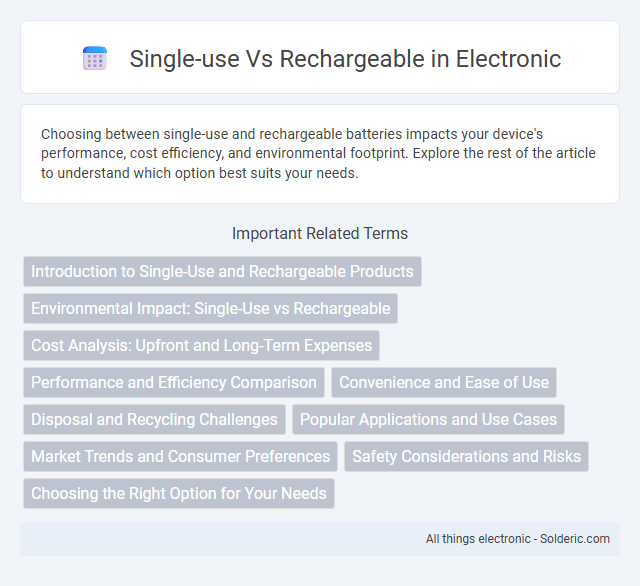Choosing between single-use and rechargeable batteries impacts your device's performance, cost efficiency, and environmental footprint. Explore the rest of the article to understand which option best suits your needs.
Comparison Table
| Feature | Single-Use Batteries | Rechargeable Batteries |
|---|---|---|
| Cost per Use | Higher | Lower over time |
| Environmental Impact | Higher waste generation | Reduced waste, eco-friendly |
| Energy Capacity | Fixed, cannot be recharged | Variable, can be recharged multiple times |
| Convenience | Ready to use, no charging needed | Requires charging, initial setup |
| Lifespan | Single use | Hundreds to thousands of cycles |
| Performance | Consistent until drained | Performance may degrade over cycles |
| Common Types | Alkaline, Zinc-Carbon | NiMH, Li-ion |
Introduction to Single-Use and Rechargeable Products
Single-use products are designed for one-time use and disposal, often made from inexpensive materials to minimize production cost. Rechargeable products incorporate batteries or components that can be reused multiple times, reducing waste and long-term expenses. Choosing between single-use and rechargeable options impacts environmental sustainability, cost efficiency, and user convenience.
Environmental Impact: Single-Use vs Rechargeable
Single-use batteries generate significant environmental waste due to their disposable nature and often contain toxic metals like mercury and lead, which contribute to soil and water pollution. Rechargeable batteries, though requiring energy and resources for production, reduce overall waste by lasting for hundreds of charge cycles and can be recycled to recover valuable materials such as lithium, cobalt, and nickel. Life cycle assessments demonstrate that rechargeable batteries have a considerably lower environmental footprint over time compared to single-use alternatives.
Cost Analysis: Upfront and Long-Term Expenses
Single-use batteries typically have a lower upfront cost but accumulate higher long-term expenses due to frequent replacements. Rechargeable batteries involve a higher initial investment but offer significant savings over time by reducing the need for continuous purchases. You save money in the long run with rechargeable options, making them cost-effective for frequent or heavy use.
Performance and Efficiency Comparison
Rechargeable batteries often deliver superior performance with consistent voltage output and longer lifespan, minimizing device downtime compared to single-use batteries that tend to degrade quickly and lose power during use. Efficiency-wise, rechargeable options reduce waste and lower long-term costs, while single-use batteries are more convenient for occasional or emergency use due to their initial readiness and lower upfront expense. Understanding your device's power demands helps determine whether single-use or rechargeable batteries best optimize performance and efficiency for your needs.
Convenience and Ease of Use
Single-use batteries offer immediate convenience with no charging required, making them ideal for low-drain or occasional devices. Rechargeable batteries provide ease of use through long-term cost savings and environmental benefits, though they require access to chargers and increased initial setup time. Device compatibility and frequency of use often determine whether single-use or rechargeable options deliver the best practical convenience.
Disposal and Recycling Challenges
Single-use batteries create significant disposal challenges due to their toxic components, which can contaminate soil and water if not properly recycled. Rechargeable batteries reduce waste by offering multiple uses but require specialized recycling processes to recover valuable metals like lithium, cobalt, and nickel. You can minimize environmental impact by selecting rechargeable options and ensuring proper disposal at certified recycling centers.
Popular Applications and Use Cases
Single-use batteries are widely favored in low-drain devices such as remote controls, smoke detectors, and flashlights due to their long shelf life and convenience. Rechargeable batteries dominate in high-drain applications like digital cameras, smartphones, and cordless power tools, offering cost efficiency and environmental benefits over time. Industries requiring frequent battery replacement, including healthcare equipment and portable electronics, increasingly rely on rechargeables for sustainability and performance.
Market Trends and Consumer Preferences
The market for rechargeable batteries is expanding rapidly, driven by increasing consumer demand for sustainable and cost-effective power solutions compared to single-use batteries, which are facing decline due to environmental concerns. Rechargeable batteries offer long-term savings and reduced waste, appealing to eco-conscious buyers and tech enthusiasts, while single-use batteries remain popular for low-drain devices and convenience in emergency situations. Industry reports indicate that innovations in lithium-ion technology and rising government regulations against disposable batteries are accelerating the shift toward rechargeable options globally.
Safety Considerations and Risks
Single-use batteries generally pose lower safety risks due to their sealed construction and limited chemical exposure, reducing the likelihood of leaks or explosions. Rechargeable batteries, especially lithium-ion types, require careful handling and appropriate charging devices to prevent overheating, thermal runaway, and potential fires. Proper storage and disposal are essential for both types to minimize environmental hazards and maintain user safety.
Choosing the Right Option for Your Needs
Single-use batteries offer convenience and reliability for low-drain devices with infrequent use, providing a longer shelf life and immediate availability. Rechargeable batteries are cost-effective and environmentally friendly for high-drain gadgets, delivering consistent power output through multiple charge cycles. Assess your device's energy demands, usage frequency, and budget to determine the most efficient and practical battery solution.
Single-use vs Rechargeable Infographic

 solderic.com
solderic.com